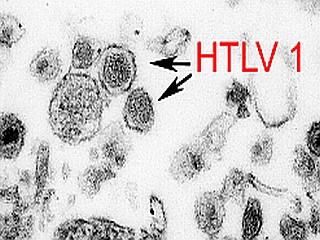The Agent
Human T-lymphotropic viruses, HTLV, comprise a family of four related retroviruses that affect T-cells, a type of white blood cell. The viruses are thought to have passed from monkeys into humans, and simian counterparts of three of the four viruses have been identified. While HTLV-1 has been known since ancient times, HTLV-3 and HTLV-4 have emerged only recently.
HTLV-1 is the most prevalent member of the family. More than fifteen million people worldwide are thought to be infected. HTLV-1 is acquired through blood transfusions, sexual contact, or needle sharing. While most people who are infected with HTLV-1 do not exhibit any symptoms, up to 5% of infected people will develop a type of leukemia called adult T-cell leukemia/lymphoma or a chronic neurological disease named HTLV-1 associated myelopathy/tropical spastic paraparesis. HTLV-2 infection has not been associated with any human disease.
In 2005, two new HTLV members were discovered in humans who had hunted monkeys in Cameroon. As in the emergence of HIV, experts believe that this is another example of an emerging disease caused by viruses jumping from monkeys into humans.
The new viruses are called HTLV-3 and HTLV-4. HTLV-3 is closely related to a previously discovered monkey virus named STLV-3 (S stands for simian) that infects many species of monkeys. HTLV-4 is a distinct virus for which no counterpart in another species is yet known to exist.
Whether HTLV-3 or HTLV-4 infection can give rise to human disease is presently not known, but the incubation period for HTLV-1, like HIV, to cause disease can take many years.
The Problem
Very little is currently known about HTLV-3 and HTLV-4. It is unclear how many people may be infected with these viruses, whether they can spread from person to person and become established within a community, or even if they cause illness.
However, given the fact that a related virus, HTLV-1 is known to cause serious diseases, it is important to monitor the possible spread of these viruses and to determine their disease potential. There is also still much to be learned about HTLV-1 and at this time there is no cure or treatment.
The appearance of these new viruses serves as a reminder that increased contact between humans and primates enhances the likelihood that a virus will cross species, as occurred when HIV was transmitted from chimpanzees into humans. Our experience with HIV has taught us that we need to be vigilant when new viruses arise in humans.
The Research
A key protein of HTLV-1 that is necessary for the virus to cause disease goes by the name of Tax-1. This protein regulates the expression of other viral genes and has the ability to transform normal cells into cancerous ones and produce tumors in experimental animals.
Dr. Susan Marriott’s laboratory studied the molecular interactions of the Tax-1 protein for many years to understand how it functions in causing cancer. Her laboratory also investigated the Tax protein of HTLV-3, termed Tax-3. Tax-3 is quite similar to Tax-1 in its genetic sequence, and it may share its molecular properties. They found that Tax-3 has a similar distribution within cells and has a similar ability to interact with important regulatory proteins in cells as does Tax-1. Furthermore, Tax-3 contains a region called a PDZ domain that is critical for the ability of Tax-1 to cause cells to become cancerous, suggesting that Tax-3 may also be capable of transforming cells.
In addition, Dr. Marriott worked with collaborators at the CDC to develop reagents that can be used to determine the prevalence of HTLV-3 infection in humans and to investigate the possibility that this virus infection is associated with a human disease.
Glossary
Learn more about some of the technical terms found on this page by visiting our glossary of terms.








 Credit
Credit
